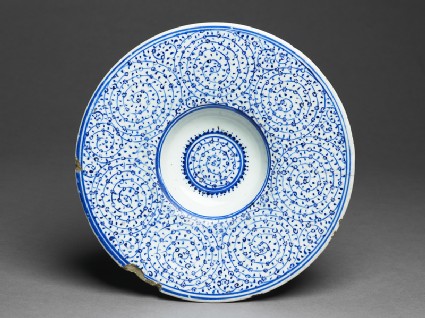Browse: 655 objects
Tondino dish with spiral patterning
-
Description
This dish is a good example of the cross-cultural exchange that occurred between Europe and the Islamic world during the early modern period. Dishes in this shape - known as tondino have a broad, flat rim and small, bowl-shaped center, and were a popular form in 16th century Italian maiolica production. The decorative style on this dish, however, is typical of Ottoman ornamentation from the first half of the 16th century. Characterized by leafy spirals painted in cobalt blue, this style is known as ‘Golden Horn’, a reference to numerous fragments with similar patterns found on the southern shore of the Golden Horn, the inlet dividing Istanbul.
-
Details
- Associated place
-
Asia › Turkey › Marmara Bölgesi (Marmara) Region › Iznik (probable place of creation)
- Date
-
1535 - 1545
Ottoman Period (1281 - 1924)
- Material and technique
- fritware, with underglaze painting in blue
- Dimensions
-
5 cm (height)
24.5 cm (diameter)
- Material index
- Technique index
- Object type index
- No. of items
- 1
- Credit line
- Presented by C. D. E. Fortnum, 1888.
- Accession no.
- EAX.3274
-
Further reading
Allan, James W., Islamic Ceramics, Ashmolean-Christie's Handbooks (Oxford: Ashmolean Museum, 1991), no. 43 on p. 68, illus. p. 69
Atasoy, Nurhan, and Julian Raby, Iznik: The Pottery of Ottoman Turkey, ed. Yanni Petsopoulos (London: Alexandria Press in association with Laurence King, 1994), no. 329, fig. 329
Glossary (2)
fritware, underglaze painting
-
fritware
Ceramic material composed of ground quartz and small quantities of clay and finely ground frit (frit is obtained by pouring molten glass into water).
-
underglaze painting
Painting applied to ceramic material before a transparent, or monochrome or coloured glaze for Islamic objects, is applied. The technique was initially developed in China.
Location
-
-
Second floor | Room 35 | West Meets East

-
Second floor | Room 35 | West Meets East
Objects are sometimes moved to a different location. Our object location data is usually updated on a monthly basis. Contact the Jameel Study Centre if you are planning to visit the museum to see a particular object on display, or would like to arrange an appointment to see an object in our reserve collections.
Collection trails
Publications online
-

Islamic Ceramics
Although documented European interest in Iznik ceramics is so scarce (nos. 46-47 [EAX.3268 & WA1888.CDEF.C324]), there was evidently a lively interchange of objects and, to a lesser extent, ideas, through regular Mediterranean trade. The Ottoman court also showed a continuing interest in Italian art. Thus, for example, from 1478-81 Costanzo da Ferrara worked in Istanbul as a medallist, and Michelangelo, even though he did not take up the invitations, was twice invited to Istanbul, once in 1506 to build a bridge over the Golden Horn and again in 1519 to paint for Sultan Selim. It is no surprise therefore to find the occasional influence of Italy in the products of Iznik. A dish in the Victoria and Albert Museum has a medallion portrait of a Turkish youth in the centre, following the fashion in Italian maiolica, and this Ashmolean piece, with its wide flat rim and small bowl-shaped recess is a ‘tondino’ dish, characteristic of the taste of Italy in the early 16th century. The design on the other hand is purely Ottoman. Objects in this style have traditionally been known as ‘Golden Horn’ ware, but the design has recently been more accurately named as the ‘Tugrakes spiral style.’ For it is derived from the illuminated spiral scroll used on royal documents as a background design for the Sultan’s tughra, or imperial monogram. In particular, it relates very closely to that on a document dating from the reign of Sultan Suleyman the Magnificent, c. 1523-36. Here, therefore, we have a ceramic design which directly reflects the taste of the imperial court.
[Bibliographic references:]
N. Atasoy and J. Raby, Iznik. The Pottery of Ottoman Turkey (London 1989) pp. 108-113.
© 2013 University of Oxford - Ashmolean Museum






